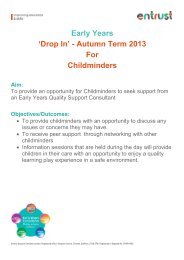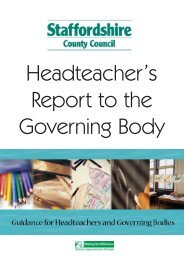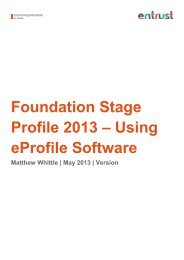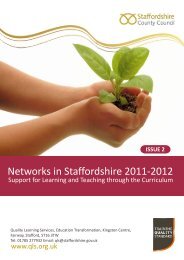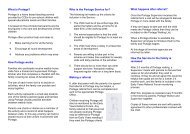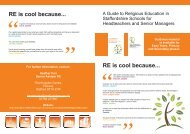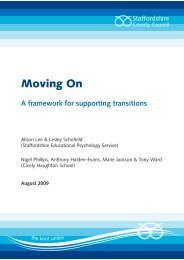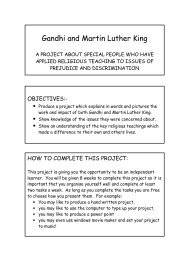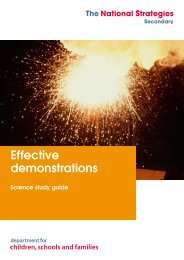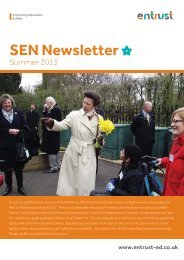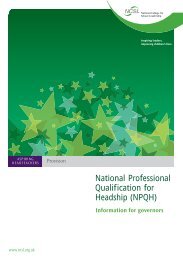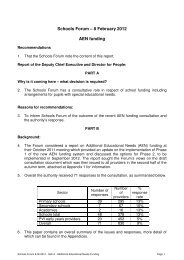Reading skills_save for pdf - Staffordshire Learning Net ...
Reading skills_save for pdf - Staffordshire Learning Net ...
Reading skills_save for pdf - Staffordshire Learning Net ...
You also want an ePaper? Increase the reach of your titles
YUMPU automatically turns print PDFs into web optimized ePapers that Google loves.
<strong>Reading</strong>: Level 1 Focus<br />
READING 1 FSP 6, 7 & 8 1C – Lower 1 1B – Secure 1 1A – Upper 1 2C – Lower 2<br />
Book Bands 2 - Red 3 – Yellow 4- Blue 5- Green 6-Orange 7-Turquoise 8 - Purple<br />
Uses knowledge of vowel digraphs and<br />
trigraphs when attempting unfamiliar<br />
words.<br />
Begins to notice when reading does not<br />
make sense and attempts to selfcorrect.<br />
Reads on sight the full range of high<br />
frequency words (e.g. Phase 5*).<br />
Blends and segments adjacent consonants<br />
and uses these <strong>skills</strong> to attempt to read<br />
unfamiliar words.<br />
Knows one grapheme <strong>for</strong> each of the 44<br />
phonemes.<br />
Reads simple familiar texts aloud with<br />
fluency and expression appropriate to the<br />
grammar (e.g. pausing at full stops and<br />
raising voice at questions).<br />
Reads on sight a range of high frequency<br />
and other familiar words (e.g. Phases 3 &<br />
4*).<br />
Identifies and talks about the main events<br />
and characters in a text.<br />
Shows a developing awareness of<br />
character and dialogue through role-play.<br />
Locates relevant parts of a text in response<br />
to simple questions.<br />
Uses knowledge of letters and soundsymbol<br />
relationships in order to read<br />
words and to establish meaning when<br />
reading aloud. In these activities they<br />
sometimes require support.<br />
Blends phonemes in order to decode CVC<br />
words, including words with common<br />
spelling patterns <strong>for</strong> long vowel phonemes.<br />
Reads, on sight, some common words (e.g.<br />
Phases 2 & 3*).<br />
Recognises familiar words in simple<br />
texts.<br />
Begins to blend phonemes in order to<br />
decode simple CVC words with short<br />
vowels.<br />
Begins to recognise some common<br />
consonant digraphs and uses phonic<br />
knowledge to attempt unknown words.<br />
Reads a range of familiar and<br />
common words (e.g. Phase 2*) and<br />
simple sentences independently.<br />
Blends sounds in words. (FSP<br />
–LSL6)<br />
Reads a range of familiar and<br />
common words and simple<br />
sentences independently.<br />
(FSP-R6)<br />
Uses phonic knowledge to<br />
read simple regular words<br />
(FSP – LSL7)<br />
Attempts to read more<br />
complex words, using phonic<br />
Assessment Focus1<br />
Use a range of strategies,<br />
including accurate decoding<br />
of text, to read <strong>for</strong> meaning<br />
Comments on obvious features of<br />
characters or setting.<br />
Re-tells stories, including most of the<br />
main events and characters, but parts<br />
may be over-long or over-short.<br />
Locates specific in<strong>for</strong>mation in the text<br />
in response to simple questions.<br />
Identifies main events or key points in a<br />
text.<br />
Answers simple literal retrieval questions<br />
about a text.<br />
Understands the structure of a simple<br />
story and uses when re-enacting or retelling.<br />
Locates significant parts of a recount and<br />
identifies the main points in correct<br />
sequence.<br />
knowledge (FSP – LSL8)<br />
Retells narratives in the<br />
correct sequence, drawing on<br />
language patterns of stories.<br />
(FSP-R7)<br />
Assessment Focus 2<br />
Understand, describe, select<br />
or retrieve in<strong>for</strong>mation,<br />
events or ideas from texts<br />
and use quotation and<br />
reference to text<br />
Uses an understanding of incidents,<br />
characters and settings to make<br />
predictions.<br />
Compares stories, identifying<br />
common themes and characters.<br />
Uses an understanding of the<br />
structure of recounts, reports and<br />
Expresses opinions about main events and<br />
characters in stories.<br />
Relates incidents from stories to own<br />
experience.<br />
Makes predictions based on title, cover,<br />
blurb, etc.<br />
In response to supportive questioning,<br />
begins to talk about events and ideas in<br />
stories.<br />
With prompting, attempts simple predictions<br />
about characters.<br />
Talks about stories and non-fiction texts,<br />
identifying major points and key themes.<br />
Uses their knowledge of simple stories to<br />
support predictions.<br />
Assessment Focus 3<br />
Deduce, infer or interpret<br />
in<strong>for</strong>mation, events or ideas<br />
from texts<br />
11<br />
instructions to make predictions.<br />
Recognises main structural features of<br />
non-fiction texts (e.g. contents, index,<br />
headings).<br />
Understands how simple diagrams and<br />
charts add in<strong>for</strong>mation.<br />
Understands the difference between fiction<br />
and non-fiction.<br />
Recognises ways to create emphasis in text<br />
(e.g. capitalisation, bold print).<br />
Begins to talk about the differences<br />
between fiction and non-fiction.<br />
Identifies the patterns and structures of<br />
rhyme and patterned text when retelling<br />
and reciting.<br />
Understands and uses correctly, terms<br />
referring to the conventions of print: book,<br />
cover, beginning, end, page, word, letter,<br />
line.<br />
Shows an understanding of<br />
how in<strong>for</strong>mation can be found<br />
in non-fiction texts to answer<br />
questions about where, who,<br />
why and how. (FSP-R8)<br />
Assessment Focus 4<br />
Identify and comment on the<br />
structure and organisation of<br />
texts, including grammatical<br />
and literary features at text<br />
level<br />
Recognises some familiar patterns of<br />
language (e.g. once upon a time; first,<br />
next, last).<br />
Begins to notice effective language<br />
choices (e.g. slimy, spooky).<br />
Makes choices from a selection of<br />
texts and begins to give reasons <strong>for</strong><br />
choices.<br />
Responds to simple questions about likes<br />
and dislikes about texts.<br />
Expresses response to poems, stories<br />
and non-fiction by identifying aspects<br />
they like.<br />
Returns to favourite books, poems,<br />
songs, rhymes to be re-read and enjoyed.<br />
Enjoys an increasing range of<br />
books.(EYFS-R[40-60+m])<br />
Assessment Focus 5<br />
Explain and comment on the<br />
writers’ use of language,<br />
including grammatical and<br />
literary features at word and<br />
sentence level<br />
Assessment Focus 6<br />
Identify and comment on<br />
writer’s purposes and<br />
viewpoints and the overall<br />
effect of the text on the<br />
reader<br />
Assessment Focus 7<br />
Relate texts to their social,<br />
cultural and historical<br />
contexts and literary<br />
traditions<br />
Reads books of own choice with some fluency and accuracy.<br />
FSP – R9 Blue = National Curriculum Level Descriptors *PNS Letters and Sounds<br />
© Staf<strong>for</strong>dshire County Council



